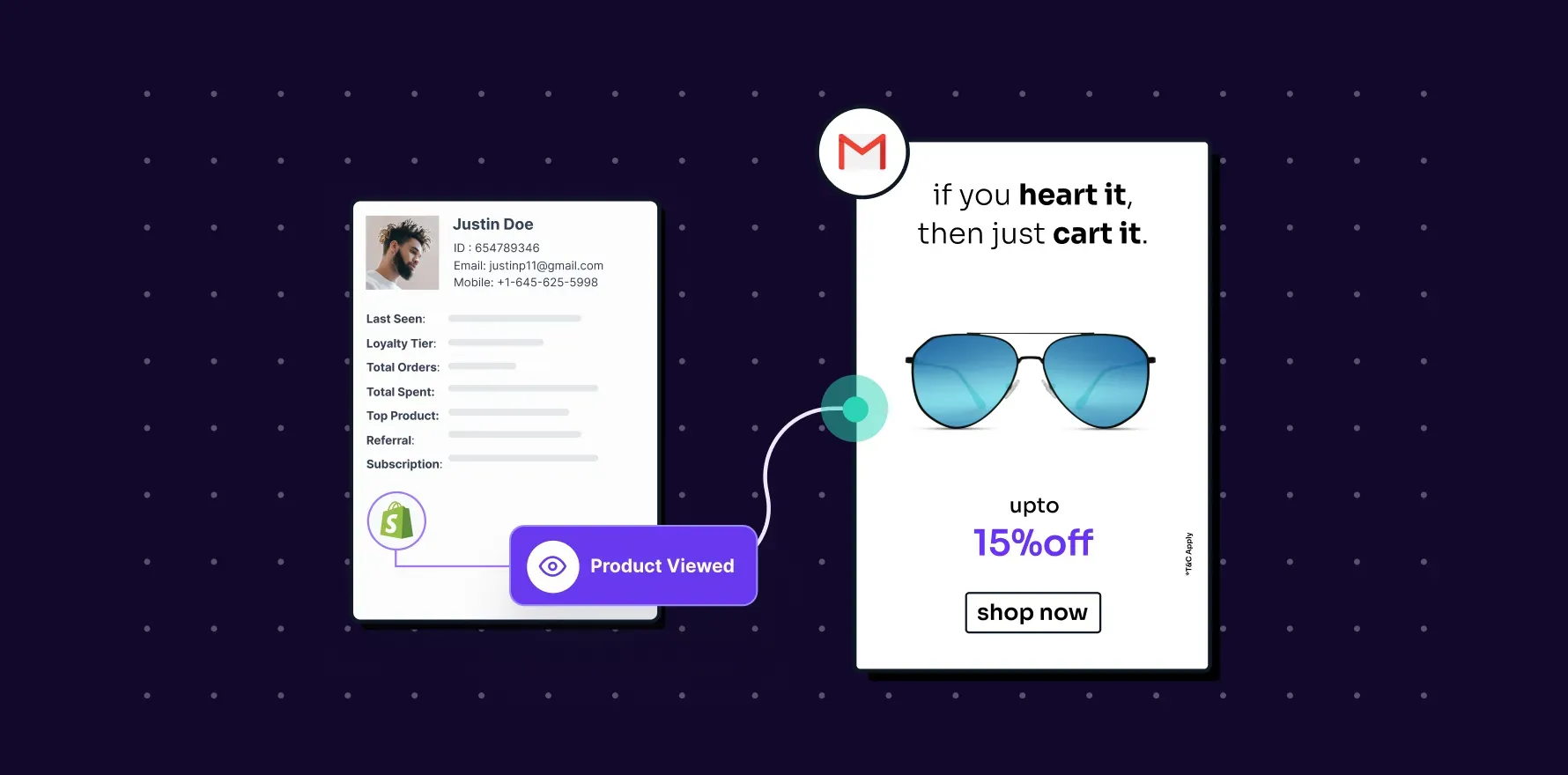The FOMO is real here. Hyper-personalized and automated triggered email campaigns can run on autopilot mode and continue to generate revenue over long periods of time. While you’ll need to invest in the initial setup of each email/campaign, once automated, triggered emails generate new and exciting levels of ROI.
How many alerts, emails, messages, and advertisements have you been exposed to today?
How many of those do you remember? Were they the ones you felt were personally addressed to you? The ones that showed you or mentioned something you have been thinking and searching for online?
Yes, it is true that we’ve been living in the era of personalization for some time now. You may have seen emails similar to this one from AirBnB:

The above email is well structured and addresses the receiver by his first name.
Such personalization worked well, but is that enough in today’s world?
Personalization is passe, hyper-personalization is here…
E-commerce companies and ecommerce marketers used basic personalization techniques to increase the chances of their messages standing out with the hopes of making themselves relevant and memorable.
However, with the evolution of ecommerce marketing, it turns out that plain personalization is not enough anymore. For example, adding your customer’s name on the subject line of an email campaign has always been a nice practice but it is not enough anymore to grab eyeballs. The time for hyper-personalization is here.
We have a lot of data (a lot!) at our fingertips, but we don’t always make the most of the opportunity it provides.
Many businesses have been extremely slow to take up hyper-personalization.71% of customers are frustrated by impersonal shopping experiences. Customers expect hyper-personalization when they’re shopping online, and are upset when brands don’t deliver it. So, why are we failing to use hyper-personalization in our marketing strategies?
It certainly isn’t because we don’t recognize the benefits. Most marketers seem to be aware of the value: 51% of marketers rate hyper-personalization as their number 1 priority.
Instead, it seems that we don’t know how to hyper-personalize our emails.58% of consumers say brands send them items that they don’t want. As this statistic shows, many ecommerce marketers clearly still don’t know what their consumers want well enough to provide properly personalized emails.
But hyper-personalization has the power to take your ecommerce business to the next level. For example, have a look at this hyper-personalized email from Only Curls:
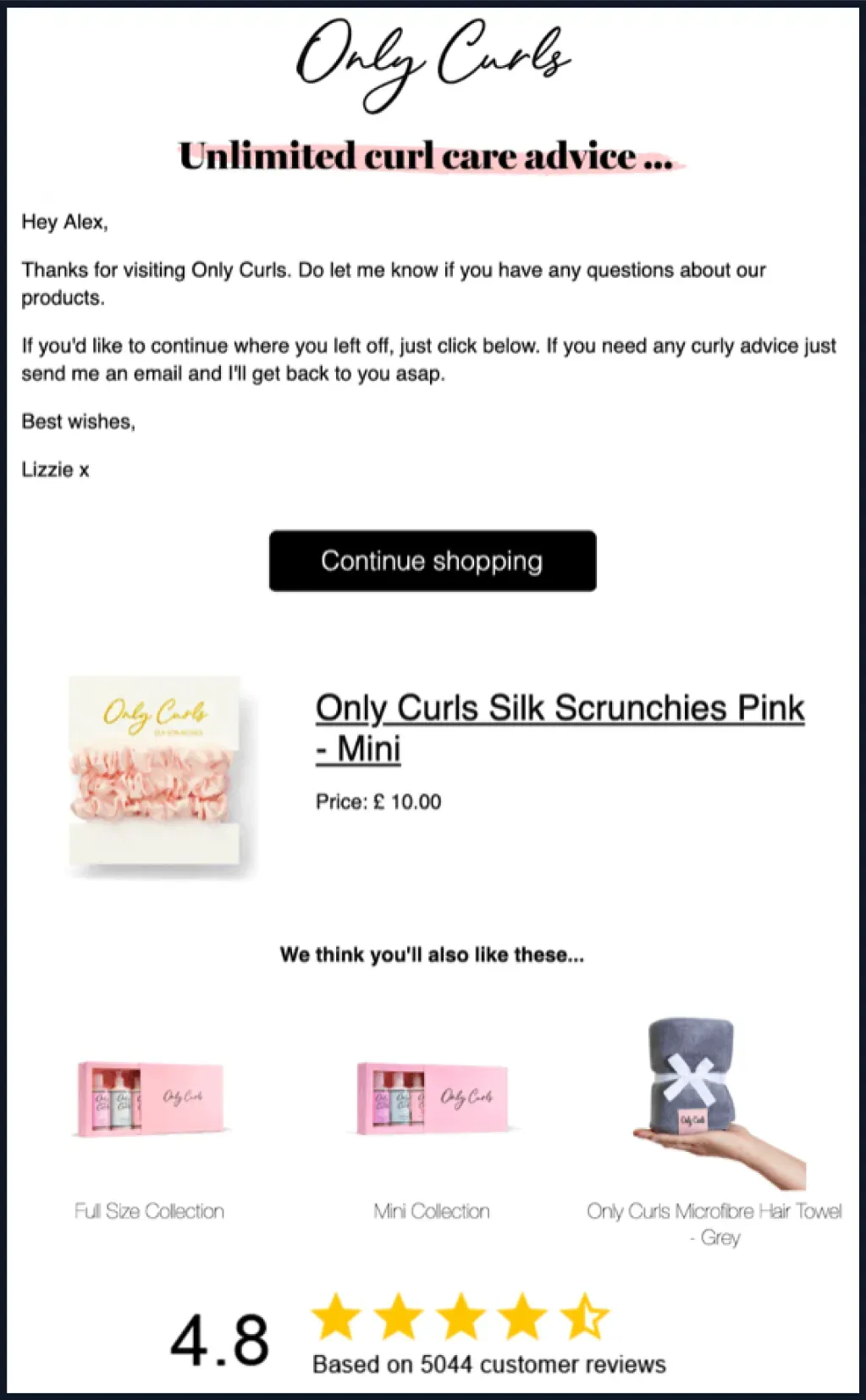
The email from hair care brand,Only Curls, combines the core abandoned shopping cart email best practices and strategies (a reminder with a CTA, related products, and social proof) with a personal touch from the founder, making this email look like it’s coming from a human even though it’s automated.
A conversational tone is used to stimulate customer participation rather than convey a message in a one-way fashion. For anyone who still may be thinking about their purchase, this note invites shoppers to reach out to the team if they have any questions or even if they’re just looking for hair care advice for their curls.
Categories of hyper-personalized data/content in your email
Each behavior/action performed or even behavior/action not done (in case of abandoned cart, for example) provides real-time, first-party data.
Hyper-personalization ensures that you’re able to add the following kinds of data-driven content elements in your email:
Automating behavior-triggered emails
Behavior-triggered emails are your brand’s automated real-time reactions to how shoppers/users/subscribers are interacting with your products or services online.
For example, you can set up automated emails for all these events/actions:
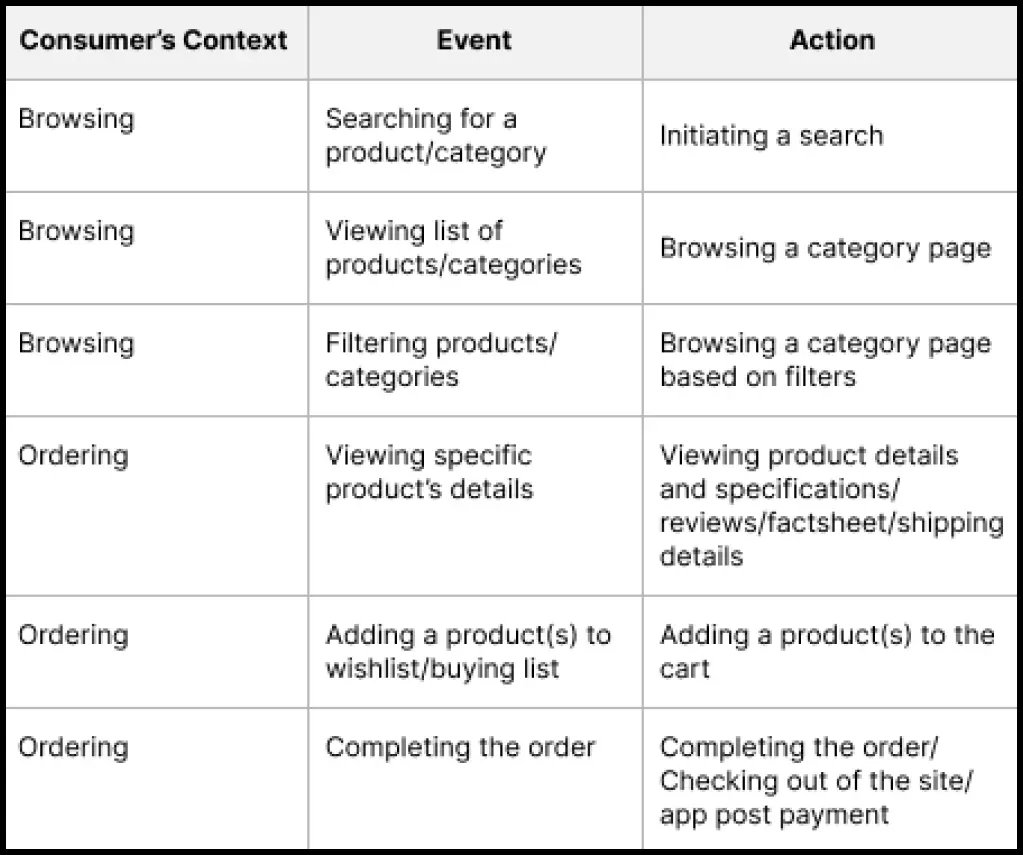
In addition, you should also send out triggered emails to welcome new users, re-engage shoppers, or upsell/cross-sell complementary products or services to them.
52% of consumers will look elsewhere if an email isn’t personalized. To avoid losing customers, you should anticipate their wants and needs and personalize your emails with specific and relevant educational content and/or product offers.
Customer Data Platform (CDP): your secret sauce for hyper-personalization
Think of your customer database as an engine. The more data you put in it the more personalization you’re able to extract. Your goal is to continuously update individual user/shopper records with preferences, demographics, and real-time behavioral information.
When it comes to hyper-personalizing your email marketing campaigns and/or messaging, you don’t have to struggle. A CDP allows you to:
- Collect data about each shopper/user from various external sources (also, called third-party data)
- Collect data on each user’s/shopper’s behavior/actions (also, called first-party data)
Remember that if you want to build a loyal and engaged DTC brand community, you can’t just connect with customers whenever you feel like it.
So, what is a CDP?
CDP stands for “customer data platform.”
A customer data platform, or CDP, is, in layman’s terms, a prebuilt software system that gathers, organizes, and centralizes customer data to create full customer profiles.
CDPs are the latest solution promising to unlock marketing automation as they create a persistent unified profile through responsibly and strategically collected first-party data.
A tale of two approaches
) Ask for information. You can encourage your users and consumers to update their records. In most subsequent interactions, you can employ pre-populated or progressive forms where they can update and add to the information you’ve already collected.But we shall delve deeper into this approach in another post
2) Gather behavioral data automatically. Your marketing automation platform will keep track of who did what, allowing you to send appropriate emails in response to the data it gathers.
Each touchpoint can become increasingly relevant to that user’s or consumer’s journey to make your marketing more timely.
In this blog post, we’ll outline multiple ways to personalize and automate triggered emails.
What is a triggered email?
When a specific event or user behavior occurs, a marketing automation system/CDP pulls the trigger and fires off an email. Such emails are known as “triggered” emails.
Categories of triggered emails
Triggered emails, based on your business goals/purposes, are generally categorized into the following types:
- Prevent lost sales– Abandoned cart is one of the leading sources of reduced sales and revenues among eCommerce businesses today.
- Nurture prospects/customers– You can turn curious window-shoppers/subscribers into customers by sending out hyper-personalized product recommendations.
- Encourage repeat purchases– After a customer has made a purchase from your online ecommerce store, turn them into repeat customers via post-purchase emails.
- Remind the customer to purchase– Send hyper-personalized product reorder/replenish/reminder emails to customers that gently nudge them to replenish specific products.
- Build customer loyalty– Build personal relationships with your customers with hyper-personalized Thank You and First Purchase Anniversary emails tailored for each recipient.
- Update customers on their order status– Send essential non-marketing emails, such as Shipping Confirmation, Delayed Shipping, Order Confirmation to keep customers updated on their order status.
Add an abandoned cart series automation
When put simply, an abandoned cart automation is a series of emails that you send to shoppers after they’ve exited your website to remind them about items they left behind in a shopping cart and persuade them to complete their purchase.
Adding an item to a shopping cart indicates interest. But that sale is not always complete immediately: the shopper may have forgotten to complete their purchase, sought out options from another brand, or just didn’t have their debit/credit card nearby.
There are two actions you must be able to track when implementing an abandoned cart automation: a customer starting checkout and the same customer finishing or not finishing their order.
When someone starts a checkout and doesn’t complete their order,that’s when you should send out your abandoned cart email/series of emails.
Here are a few other things to consider when creating an abandoned cart automation:
- How many emails will be in your abandoned cart email series?
- How will you grab attention with your subject line?
- How long do you want to wait to follow up with your shopper about their abandoned item?
- What content are you going to include in your abandoned cart emails?
- How are you going to encourage people to complete checkout—Will you simply remind them of their cart or will you present a special offer/discount?
A hyper-personalized humorous abandoned cart email works wonders:
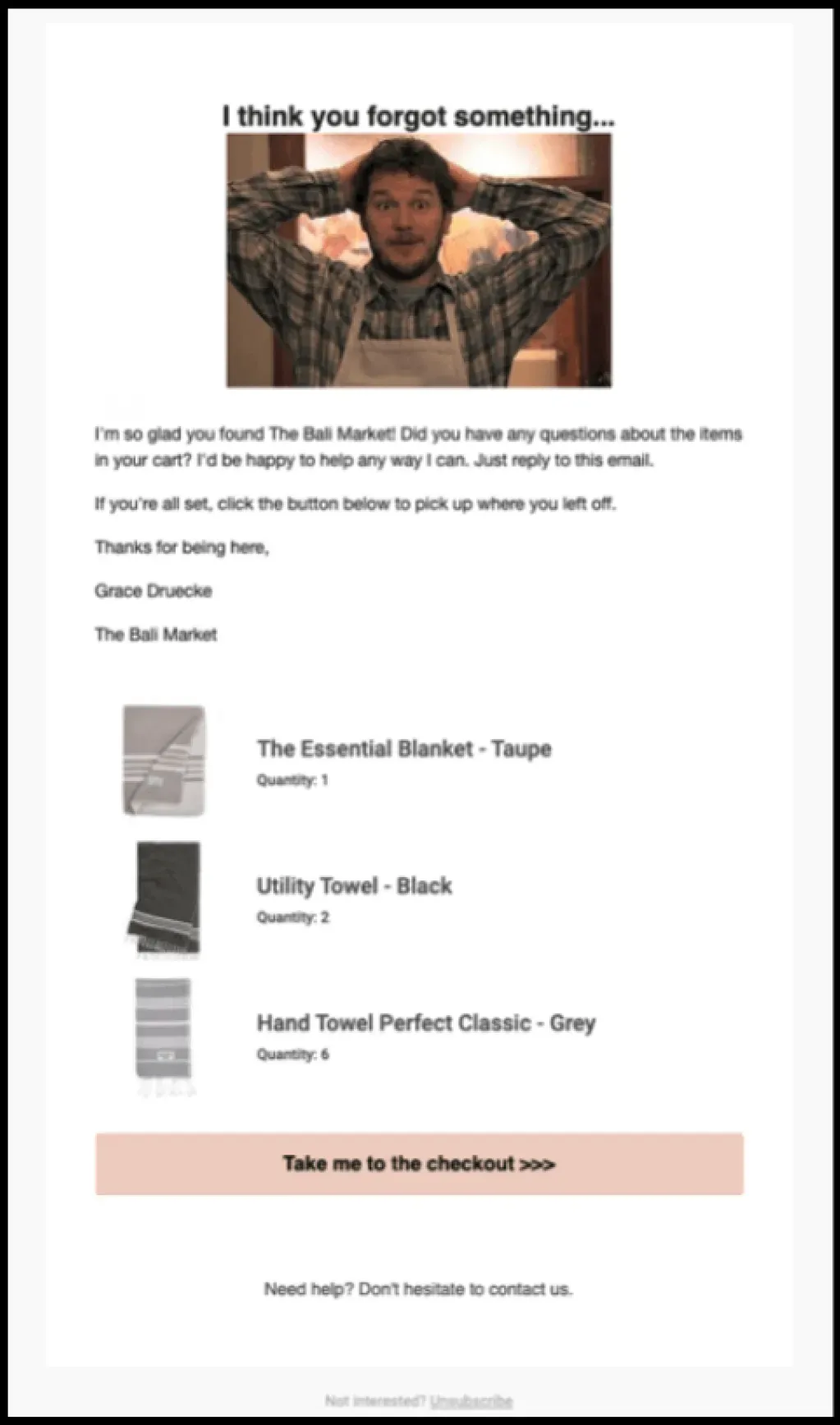
The Turkish bath towel brandThe Bali Marketinserts their sense of humor into their abandoned cart emails, which is almost always a winning strategy.
This plain text email is sure to make the recipient laugh or at least smile a bit. At the same time, it communicates the value of the brand’s products, asks whether the shopper has some questions about the specific items abandoned in their cart, and also shows the exact images of the items left in the cart.
This hyper-personalized approach to the abandoned cart email is sure to catch people’s attention, intrigue them, and entice them into taking another look at the brand’s products. Or maybe even buying them after receiving this email.
Automate product recommendation emails
Click Through Rate (CTR) is all about the content within your email. And this is where the magic happens.
If the content of your emails are relevant to shoppers, you’ll wind up with a great CTR. Include relevant, hyper-personalized content in your emails, and you’ll get shoppers clicking through your emails and back onto your site.
All of the traffic that abandoned your ecommerce site is likely to come rushing back.
First of all, ask yourself, “Is this email message relevant to each individual shopper or is it generic and too broad? Do my product recommendation emails match various user behavior or are they just a catch-all for all site traffic?”
Sending a generic email to all shoppers just doesn’t cut it. So how can you use product recommendations to make your emails appealing and relevant to each individual shopper and, as a result, increase your CTRs?
A shopper known to/identified byCalvin Kleinmay have typed in a search term on their site yet did not go on to view any categories, products, or add anything to their carts. So, Calvin Klein sent an email that displayed recommendations of top sellers within the category related to the search performed by the shopper:
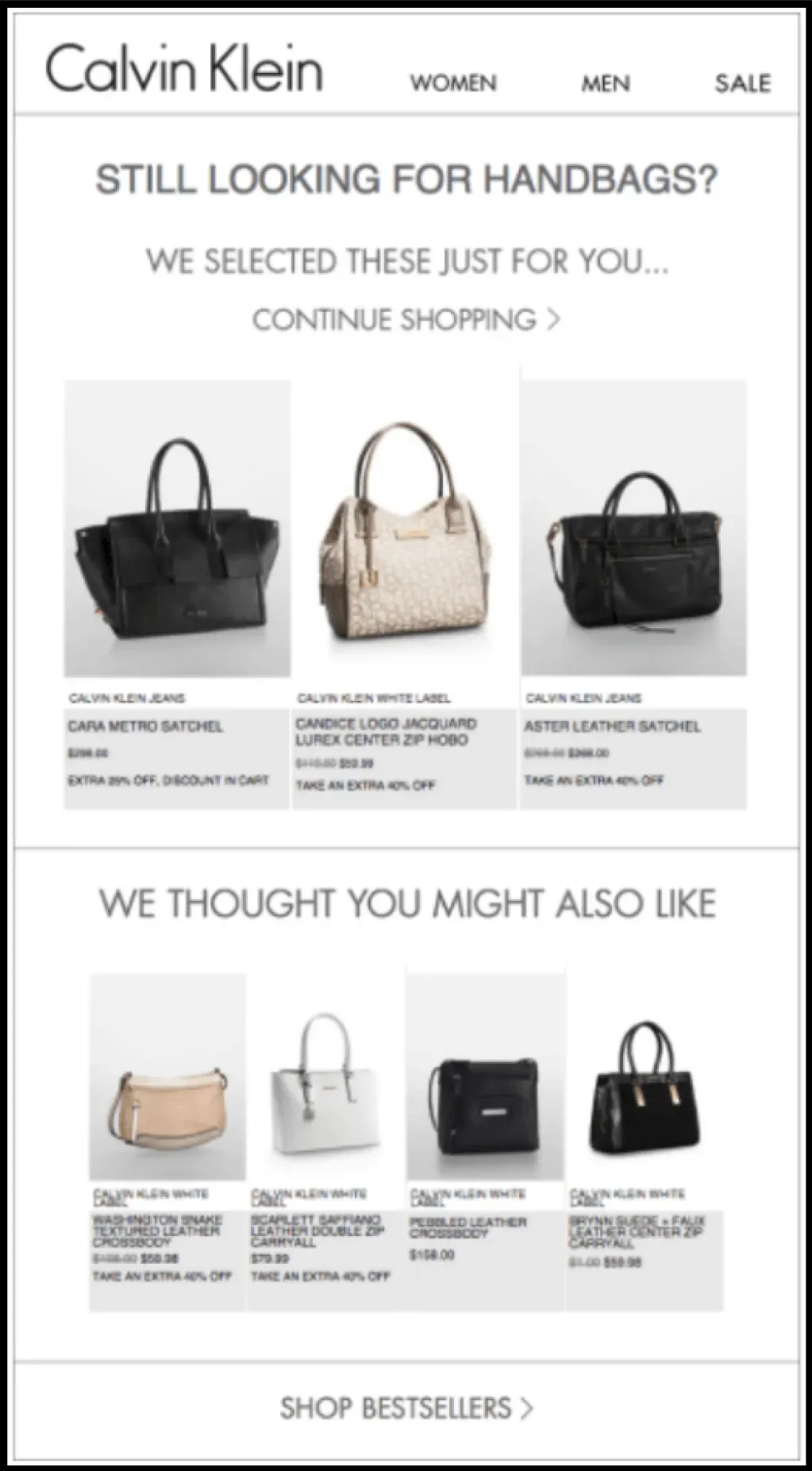
We like how Calvin Klein used different types of recommendations within one email that matches the searched term. They also use great images.
Automate post-purchase emails
Automating post-purchase emails can enable customer engagement and long-term brand loyalty by:
- Educating shoppers about the product– If there are certain steps they should take to use your product, use such an email series to demonstrate how to use the product.
- Motivating people to make their next purchase– Showcase what other products you have to offer—and give first-time consumers a reason to return to your website/app.
- Collecting feedback– The final post-purchase email in the series may be used to collect rating, reviews, testimonials, and any other user-generated content from your happy customers.
- Thanking them– Show appreciation for choosing your business and product.
Such hyper-personalized emails help to humanize your brand and strengthen the emotional bond between you and your shoppers.
For example, check out howBrava Fabrics, a sustainable and ethical clothing brand, uses a thank you email to reward shoppers, who have recently purchased from them with an exclusive offer.
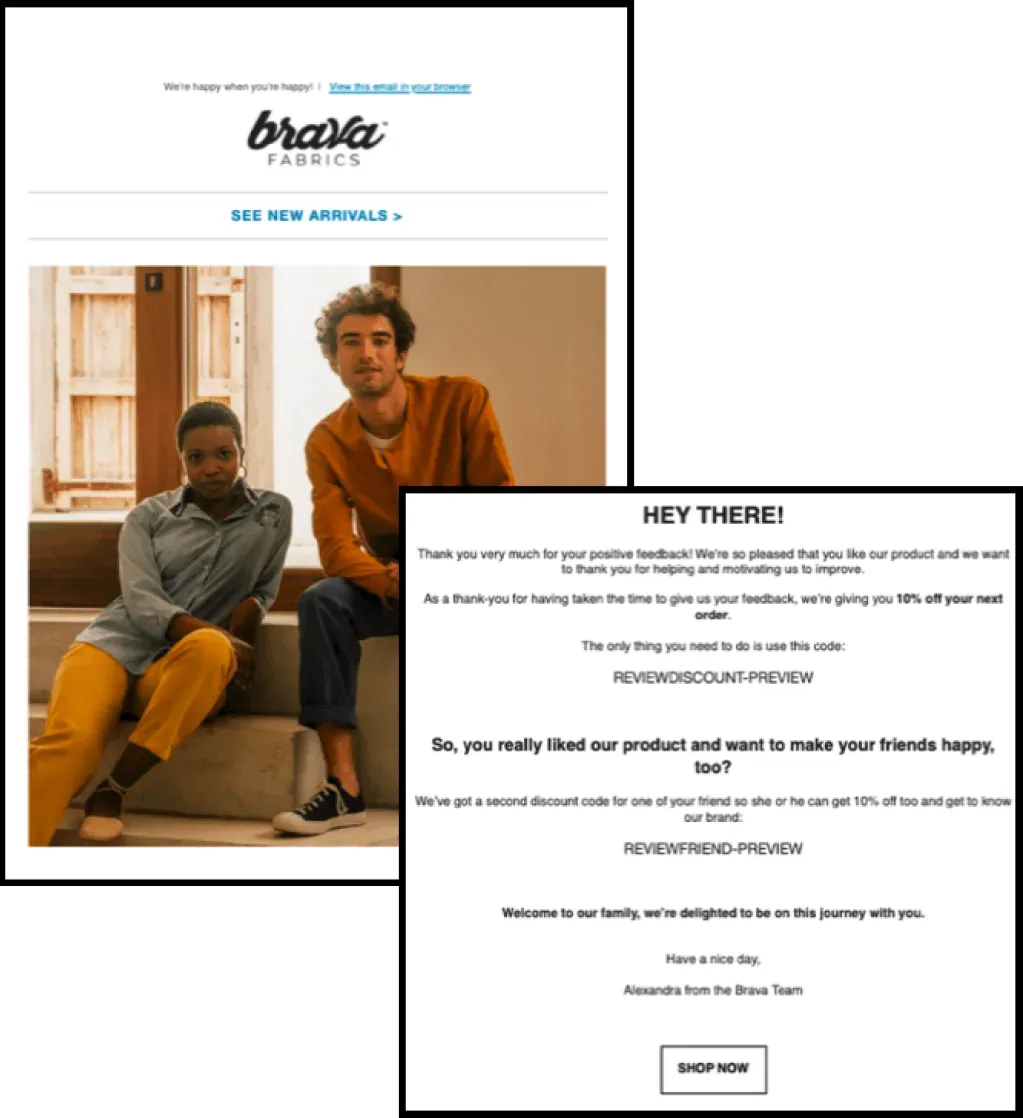
After collecting reviews from shoppers, they sent thank you emails based on their reviews. They also added a human touch: “Welcome to our family”.
Automate reorder/replenish/reminder emails
Think about which of your customers will need to replenish supplies at regular intervals or order per season. Track such behavior continually. And create an automated reorder campaign accordingly. Such emails are also known as product replenishment or product reminder mails.
You can increase your Customer Lifetime Value (CLV) by building and triggering a few hyper-personalized email ideas from this short list:
- New product updates to business clients (such as software or office stationeries)
- Seasonal product order reminders (calendars and seasonal apparel, fruits, sports equipment, merchandise based on recent movies/comics/books, etc.)
- Updates for items that were out of supply/stock
- Refill orders for regularly/periodically bought products (e.g. food items, milk, printer ink cartridges, etc.)
You can also use a few of these ideas to create hyper-personalized automated reorder/reminder/replenish emails:
- Send your reordering emails around each consumer’s standard purchase cycle.
- Hyper-personalize an email by calculating your customer’s average reorder timeline via their tracked order history.
- Consider discounts and special offers, if the customer does not re-order.
- Include details of what they purchased previously, a product image, reviews, and a URL for reordering in your behavior-triggered email.
- Incentivize your frequent buyers to send referrals to their friends and network.
- Send short educational content.
- Upsell/cross-sell related and complementary products. For example, if someone purchased a blue dress shirt from your site, you could use an upsell or cross-sell email campaign to automatically recommend a pair of pants or a skirt that they could wear with their new blue shirt.
The best way to think of replenishment emails is as a crossover between a post-purchase email and an abandoned cart email.
Why? Because, in a sense, they’ve indicated a desire and purpose to acquire a thing, and you’re treating them as such.
In the same way that an abandoned cart email focuses on the product, a replenishment email focuses on the item you’re persuading the customer to restock.
Additionally, simple copy, product imagery, details, and recommendations, and a clear call-to-action (CTA) go a long way like in this example from Briogeo:

Why should you pull the trigger on time
Hyper-personalizing your emails and automating them based on real-time behavioral triggers will help you work smarter and not harder.
Lifesight is all set to launch an exciting new product that will enable you to set up hyper-personalized emails with real-time behavioral data (first-party data).
You may also like
Essential resources for your success
